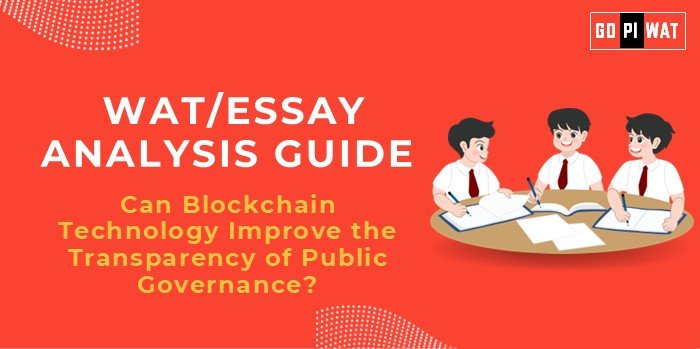📋 WAT/Essay Analysis Guide: Can Blockchain Technology Improve the Transparency of Public Governance?
🌟 Understanding the Topic’s Importance
Blockchain holds immense potential in governance, ensuring transparency and reducing corruption. Its relevance spans across auditing, citizen services, and voting systems, aligning closely with the values of accountability and integrity emphasized in public administration.
📝 Effective Planning and Writing
- ⏳ Time Allocation:
- 📖 Reading & Planning: 5 minutes.
- ✍️ Writing: 20 minutes.
- 🔍 Review: 5 minutes.
💡 Introduction Techniques for Essays
- ⚖️ Contrast Approach: “While blockchain powers the $1 trillion cryptocurrency market, its use in public governance is yet to realize its full potential.”
- 🌱 Solution-Based Approach: “Blockchain offers a pathway to minimize corruption and enhance transparency in governance through immutable record-keeping.”
📚 Structuring the Essay Body
- ✅ Achievements: Highlight case studies such as Estonia’s e-residency or India’s land record initiatives.
- ⚠️ Challenges: Discuss cost barriers, scalability, and cybersecurity concerns.
- 🔮 Future Outlook: Propose integrating blockchain with other technologies like AI for improved governance.
📌 Concluding Effectively
- ⚖️ Balanced Approach: “Blockchain represents a promising yet challenging solution to governance transparency. Its success hinges on infrastructure and policy frameworks.”
- 🌍 Global Comparison Approach: “By learning from Estonia and addressing local barriers, countries can unlock blockchain’s transformative potential.”
✨ Recommendations for Sustainable Progress
- 🤝 Public-Private Partnerships: Mobilize resources and expertise for blockchain adoption.
- ⚖️ Regulatory Frameworks: Establish clear policies to govern blockchain usage.
- 📚 Capacity Building: Train officials in blockchain technology.
📄 Sample Short Essays
- ⚖️ Balanced Perspective: “Blockchain technology is poised to revolutionize public governance, offering unprecedented transparency. Yet, its implementation is fraught with challenges like high costs and scalability issues. With targeted investments and strategic policies, blockchain can become a cornerstone of accountable governance.”
- 💡 Solution-Oriented: “To combat corruption and enhance transparency, blockchain provides a robust solution. Case studies like Estonia highlight its potential, but widespread adoption will require addressing barriers such as technical expertise and cybersecurity threats.”
- 🌍 Global Comparison: “Estonia’s blockchain-powered governance stands as a beacon of transparency. Countries like India can replicate this success by focusing on scalable solutions and fostering global collaborations.”


